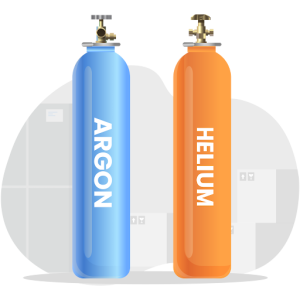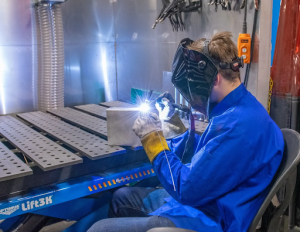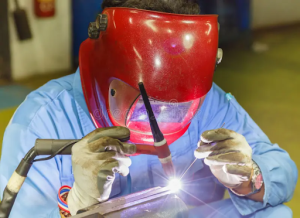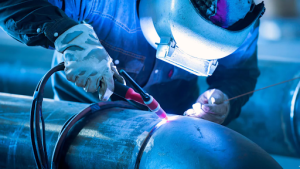TIG Welding Gases: What to Use and Why
TIG welding, also known as Gas Tungsten Arc Welding (GTAW), is trusted for producing clean, precise, and high-quality welds. Whether you are working on stainless steel, aluminium, copper, or special alloys, using the right TIG welding gas makes a huge difference. Shielding gases protect the weld pool from the surrounding air, improve arc stability, and help you get the finish you want.
In this guide, we break down the essential gases for TIG welding, explain where each one works best, and help you understand which is the best gas for TIG welding in different situations.
What Makes TIG Welding Different?
Unlike MIG or stick welding, TIG uses a non-consumable tungsten electrode and a slow, controlled welding process. Because the arc is very clean and sensitive, the weld must be protected from oxygen, nitrogen, and hydrogen in the air. That is where shielding gases come in.
Your choice of TIG welding gas determines:
- Penetration
- Arc stability
- Heat input
- Weld appearance
- Weld strength
- Cost of operation
The wrong gas can cause porosity, contamination, spatter, unstable arcs, or shallow penetration. The right gas makes the process smoother, cooler, or hotter, depending on the metal you are welding.
For more details, also read MIG vs TIG Welding: Which is Best for Your Project?

Main Gases Used in TIG Welding
Below are the most widely used gases for TIG welding, along with how they behave and when to pick them.
1. Argon – The Most Common TIG Welding Gas
Argon is the number-one choice for TIG welding worldwide. Almost every guide and industry source agrees that argon gas for TIG welding is the standard for both beginners and professionals.
Why is argon preferred
- Gives a smooth, stable arc
- Easy arc starting
- Affordable and widely available
- Works on most metals (steel, stainless steel, aluminium, copper, titanium, nickel alloys)
- Great for thin metals
Where argon is used
Argon is the best gas for TIG welding aluminium, stainless steel and many non-ferrous metals. Because aluminium needs steady heat control and a clean arc, argon helps prevent contamination and gives a soft, manageable arc profile.
When to choose pure argon
- Everyday TIG welding jobs
- Thin sheets or delicate parts
- Aluminium fabrication
- Stainless steel work
- Welding at low amperage
If you are unsure where to start, pure argon is almost always the safest and most cost-effective choice.
2. Helium – For More Heat and Deep Penetration
Helium is another inert gas often used in TIG welding, especially when higher heat is needed.
Why helium matters
- Provides a hotter arc
- Increases heat transfer
- Improves penetration on thick or high-conductivity metals
- Speeds up travel rate
When helium works best
Helium is perfect for:
- Thick aluminium
- Thick copper and copper alloys
- Magnesium
- Metals with high thermal conductivity
- Welds that need strong, deep penetration
Drawbacks of helium
- More expensive than argon
- Arc start is harder
- Less stable arc
- High flow rates are needed
Due to these limitations, many welders blend helium with argon to reap the benefits of both.

3. Argon–Helium Gas Mixtures – The Best of Both Worlds
Argon–helium mixtures are designed to combine argon’s stability with helium’s high heat.
Benefits of Ar–He mixes
- Better penetration than pure argon
- More heat for thick metals
- Smoother arc than pure helium
- Improved productivity
- Suitable for automated welding
Typical uses
These mixtures are popular in industries that weld:
- Thick aluminium plates
- Copper and bronze
- Heat-conductive alloys
- Large or structural components
Common mixture ratios
- 75% argon / 25% helium
- 50% argon / 50% helium
- 25% argon / 75% helium (rare but very hot arc)
As the helium percentage rises, penetration increases, but arc starting becomes more difficult. If you’re unsure which shielding gas suits your project, Kirmell can help you with expert welding support and material advice tailored to your requirements.
4. Hydrogen – Used Only in Small Mixtures
Hydrogen is not an inert gas, but a tiny amount (usually up to 5%) can be added to argon to create argon-hydrogen blends.
Why add hydrogen?
- Increases heat
- Boosts travel speed
- Smooths stainless-steel weld beads
- Improves penetration
Where it is useful
Hydrogen blends are used on:
- Stainless steels
- Austenitic steels
- Certain nickel alloys
Important warnings
Hydrogen should never be used on:
- Aluminium
- Carbon steel
- Titanium
It can cause porosity, cracking or hydrogen embrittlement. These blends must be handled with experience and care.

Why Shielding Gas Selection Is So Important
Choosing the right gas for TIG welding aluminium, stainless steel, copper or any other alloy directly affects your results, workflow and welding efficiency. Shielding gas does much more than protect the arc; it influences how the metal melts, how the weld bead forms and how strong the final joint becomes. Even a small change in gas type or flow can noticeably shift the performance of your torch.
1. Arc Stability
Arc stability is one of the most important factors in TIG welding. A stable arc gives you smoother control, cleaner heat input and predictable puddle behaviour.
- Argon provides the most stable arc, especially when working with thin metals or low amperage settings. This makes it ideal for aluminium and stainless steel.
- Helium, while offering more heat, produces a more aggressive arc that can be harder to manage.
- Gas mixtures help find the right balance when you need both stability and additional heat.
A stable arc reduces spatter, maintains a consistent puddle, and enables the welder to make precise, cosmetic welds.
2. Penetration
Penetration determines how deeply the weld fuses into the base metal.
- Helium-rich gases allow the heat to travel deeper, making them perfect for thick plates or metals that conduct heat quickly, such as copper or heavy aluminium.
- Argon, on the other hand, offers softer heat input, giving better control on thin sheets where too much penetration may cause burn-through.
Choosing the correct gas ensures you don’t waste time reworking welds that are too shallow or too hot.
3. Weld Quality
The weld pool is extremely sensitive to contamination. Even a small amount of air can create defects. Proper shielding gas prevents:
- Porosity
- Oxidation
- Discolouration
- Contaminated or weak welds
A clean, well-shielded weld not only looks better but performs better under stress. It also minimises the need for post-weld cleaning or grinding, saving you time and improving overall productivity.
4. Operating Cost
Shielding gas has a direct impact on operating costs.
- Argon is the most cost-effective option for everyday TIG work.
- Helium and helium blends come at a higher price but can significantly boost welding speed on thick materials. This increased productivity often offsets the higher gas cost.
Proper gas selection also reduces wasted gas, rework, and consumable use, helping both hobbyists and fabricators control expenses.
5. Efficiency and Workflow
Beyond cost and quality, the right gas improves your overall workflow:
- Faster travel speeds when using hotter helium blends
- More predictable puddle behaviour with argon
- Reduced downtime fixing weld defects
- Less post-weld cleaning required
Good shielding gas makes the welding process smoother from start to finish, allowing you to focus more on technique and less on troubleshooting.
For professional assistance with TIG setup, material selection or precision fabrication, Kirmell provides reliable UK-based services designed for both small and large-scale projects.

How Gas Flow Rates Affect TIG Welding
The best shielding gas will only perform well if it is supplied at the correct flow rate. Gas flow controls how effectively the weld pool is protected from the surrounding air. Too much or too little flow can ruin the weld, even if you’re using the ideal gas mixture.
Correct Flow Rate
Most TIG welding jobs require a gas flow between 10–35 cubic feet per hour (cfh). Lighter materials and small nozzles usually need lower flow, while larger nozzles or drafty environments require slightly higher flow. The aim is to create a soft, even “cloud” of shielding gas around the arc without causing turbulence.
Effects of Low Gas Flow
If the flow rate is too low, the shielding gas cannot fully cover the weld pool. This leads to:
- Poor shielding, allowing oxygen and nitrogen to enter the weld
- Weld contamination, which appears as black soot or porosity
- Arc instability makes it difficult to control the puddle
Low flow generally results in weak, inconsistent welds that require reworking.
Effects of High Gas Flow
Too much gas pressure is just as harmful. Excessive gas flow causes:
- Turbulence around the torch, which pulls the surrounding air into the weld
- Contaminated welds, even when using pure argon
- Wasted gas, increasing operating costs unnecessarily
- Porosity and oxidation, especially on stainless steel or aluminium
High flow creates a swirling effect that disrupts the shielding protection instead of strengthening it.
Achieving Smooth, Laminar Gas Flow
The goal is smooth, laminar (non-turbulent) gas flow. This ensures the shielding gas moves softly around the tungsten and weld pool. Tools like a gas lens help achieve this by distributing gas more gradually and evenly. A gas lens also allows more tungsten stick-out, giving better access to tight joints and improving shielding on critical or cosmetic welds.

Torch Setup and Nozzle Choice
Your torch setup plays a major role in how well your shielding gas works. Even with the right flow rate and gas type, poor torch components or improper nozzle selection can weaken gas coverage and reduce weld quality.
Gas Lens
A gas lens replaces the standard collet body with a series of fine screens that straighten and distribute the gas more evenly. Benefits include:
- More uniform gas coverage over the weld pool
- Better protection in awkward angles or open-root welds
- Longer tungsten extension, helpful for joints that require extra reach
- Cleaner weld appearance, especially on stainless steel and titanium
Gas lenses are preferred when welding thin metals or making high-precision, visually clean welds.
Standard Collet Body
A standard collet body directs gas in a simpler, less controlled way. It works well for general-purpose welding but provides:
- Less laminar flow, which can be an issue on reactive metals
- Reduced shielding efficiency in tight corners or high-heat applications
It remains a reliable choice for everyday steel welding and simpler jobs.
Nozzle Selection
The nozzle, or gas cup, controls how gas exits the torch and surrounds the weld. Choosing the right size and shape is important for consistent results.
- Large nozzles
Provide a wide gas spread and better coverage, ideal for fillet welds, larger beads or cosmetic stainless steel welds. However, they may reduce access in small spaces.
- Small nozzles
Offer better access but less coverage. A smaller cup should be paired with lower gas flow to avoid turbulence.
- Speciality nozzle shapes
- Converging cups focus gas in a narrower, more controlled stream.
- Champagne-style cups help guide gas smoothly and reduce turbulence.
These options are useful for sensitive materials like aluminium or titanium.
Matching Torch Setup to the Job
The right combination of gas lens, collet body and nozzle ensures:
- Strong shielding around the arc
- Stable weld puddle behaviour
- Reduced contamination
- Cleaner, stronger welds
A well-set-up torch gives you more control, reduces rework, and improves the overall quality of your TIG welding.
Kirmell offers expert TIG welding services using advanced equipment and skilled welders to ensure clean, strong, and accurate results. Get in touch with our team to learn more.
Choosing the Best Gas for TIG Welding
There is no universal solution. The best gas for TIG welding depends on your metal and thickness. Here is a detailed table for your guidance:
| Material | Best Gas Option | Notes |
| Aluminium (thin) | 100% argon | Best control and clean finish |
| Aluminium (thick) | Argon–helium mix | Extra heat for deeper penetration |
| Stainless steel | 100% argon | Stable arc and clean results |
| Stainless steel (high-speed) | Argon + 1–5% hydrogen | Only for skilled use |
| Copper / Bronze | Helium or Ar–He mix | High heat needed for fusion |
| Carbon steel | 100% argon | Simple and clean welding |

Kirmell’s Professional TIG Welding Services
At Kirmell, we specialise in high-quality TIG welding for aluminium, stainless steel and a wide range of custom metal projects. Our team uses advanced equipment, precise techniques and industry-approved gases to ensure every weld is clean, strong and visually consistent. Whether you need delicate work on thin materials or deep penetration on thicker components, our welders deliver results that meet strict UK standards.
We support businesses, workshops and individual clients with reliable welding solutions designed for both small and large-scale fabrication. From prototypes to production runs, we focus on accuracy, durability and smooth finishes every time. If you’re looking for dependable TIG welding services backed by skilled professionals, contact Kirmell today to discuss your project requirements.
Conclusion
Choosing the right gases for TIG welding is essential for clean, professional, and reliable welds. Argon remains the most versatile and widely used option because it is stable, smooth, and ideal for most metals. Helium helps with thick or heat-conductive materials, while argon–helium mixtures offer flexibility for advanced work. Hydrogen blends have specialised uses but should be handled with care.
Whether you are deciding on argon gas for TIG welding, helium, or a mixture, always match your choice to your metal, thickness, and desired finish. The right shielding gas ensures stronger welds, better appearance, and a more controlled welding experience overall.
FAQs
What gas is best for TIG welding?
What gas should I use for TIG welding aluminium?
Where can I get TIG welding services?
Do shielding gases affect weld strength?



